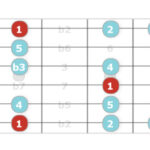The Beatles’ “Michelle” is a timeless classic, beloved by guitar players and music lovers alike. When learning to play this iconic song, you might encounter different chord charts, especially for the second chord after the initial F major. Many transcriptions suggest a Bbm7 chord, but a closer look – and listen – reveals a more nuanced and harmonically richer option: Bb7#9. This article delves into why Guitar Chords Michelle often feature a Bb7#9, arguing that it’s not just a fancy variation, but a crucial element that captures the true essence of the song’s harmony.
The debate often centers around a specific moment in the song. If you listen carefully to the original recording, particularly versions where the backing vocals are prominent, you can hear the singers clearly articulating a Bb7 sound. Furthermore, examining detailed musical scores corroborates this, indicating a Bb7 chord in the arrangement. Harmonically, Bb7 makes perfect sense in this context. It functions as the dominant 7th chord leading to the subsequent Eb6, creating a smooth and satisfying resolution. The dominant 7th chord naturally creates tension and anticipation, which beautifully propels the music forward to the Eb6 chord.
So, why the confusion and the prevalence of Bbm7 in some guitar chord transcriptions for “Michelle”? While Bbm7 isn’t entirely wrong, it misses a key ingredient that Paul McCartney himself often incorporates: the #9. Listening to live performances and analyzing McCartney’s guitar part reveals his consistent use of the #9 extension on the Bb7 chord. This isn’t just improvisation; it’s deeply connected to a recurring musical idea throughout “Michelle” – a chromatic motif.
This chromatic motif is a sequence of notes moving by semitones, adding a distinctive flavor to the song. It’s subtly woven into both the introduction and the chorus of “Michelle.”
In the intro, played on guitar, you can clearly hear a descending chromatic line in the chord progression Fm-Fm(maj7)-Fm7-Fm6-Dbmaj7-C. The top notes of these chords – F, E, Eb, D, Db, C – form a descending chromatic scale.
This chromatic idea doesn’t disappear after the intro; it continues into the chorus. In the chord progression F-Bb7#9-Eb6-Ddim7-C-Bdim7-C, the top notes – C, C#, C, B, C, B, C – outline a chromatic rise and fall, mirroring the melodic contour and adding a sophisticated harmonic layer. While perhaps less obvious than the intro’s chromatic descent, this ascending and descending movement is still present and contributes to the song’s unique character.
Therefore, the Bb7#9 chord in “Michelle” serves a dual purpose. Firstly, it functions traditionally as the V7 chord, the dominant 7th of Eb, creating harmonic drive. Secondly, the #9 (C#) is not just an arbitrary addition; it’s integral to maintaining the chromatic motif that permeates the song. Adding the #9 to the Bb7 chord also injects a touch of dissonance, which is consistent with the song’s harmonic language. “Michelle” masterfully balances consonant chords (like F, Eb6, and C) with slightly dissonant chords (like Bb7#9, Dbdim7, and Bdim7), creating a rich and engaging listening experience.
It’s understandable why simplified chord charts might opt for Bbm7. It’s a simpler chord to play and still functions somewhat within the harmonic context. Indeed, many online resources offer chord sheets with Bbm7, and even Gm7 (if the key is considered D minor) or Bbm7 in F major arrangements. However, more detailed and arguably more accurate scores, especially those intended for purchase and professional use, often notate Bb7#9. These versions, frequently in F minor and designed for piano reductions, feature the Bb7 chord, sometimes explicitly including the #9, reinforcing the idea that the intended harmonic underpinning, especially as represented by the backing vocals in the recording, is indeed Bb7. Paul McCartney’s addition of the #9 on guitar in performances then elevates this further, highlighting the chromaticism inherent in “Michelle”.
In conclusion, while Bbm7 might be an acceptable simplification for playing guitar chords Michelle, understanding and utilizing Bb7#9 unlocks a deeper appreciation for the song’s harmonic sophistication. It acknowledges the intended dominant function, respects the backing vocal arrangement, and, most importantly, embraces the chromatic motif that is so central to the musical identity of “Michelle.” For guitarists seeking accuracy and a richer harmonic palette, Bb7#9 is undoubtedly the more musically rewarding choice.

